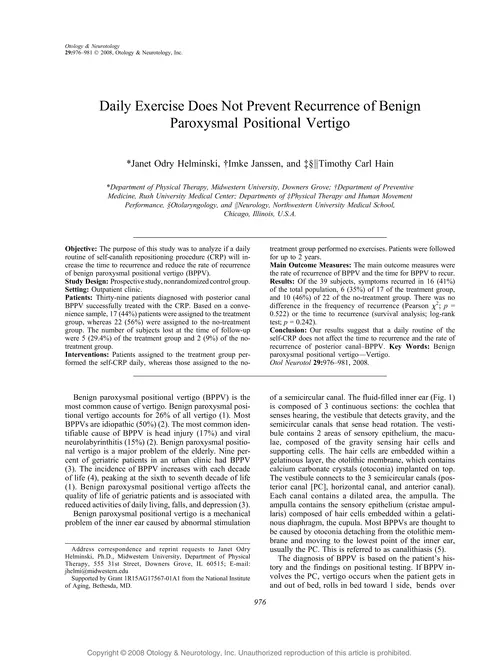
Daily Exercise Does Not Prevent Recurrence of Benign Paroxysmal
There are several variants of BPPV (Benign Paroxysmal Positional Vertigo) which cases are seen as a consequence of an Epley maneuver, but others find
adsPart of the document
Copyright @ 200 Otology & Neurotology, Inc. Unauthorized reproduction of this article is prohibited.8
Daily Exercise Does Not Prevent Recurrence of Benign
Paroxysmal Positional Vertigo
*Janet Odry Helminski,Imke Janssen, and§kTimothy Carl Hain
*Department of Physical Therapy, Midwestern University, Downers Grove;ÞDepartment of Preventive
Medicine, Rush University Medical Center; Departments ofþPhysical Therapy and Human Movement
Performance, §Otolaryngology, andkNeurology, Northwestern University Medical School,
Chicago, Illinois, U.S.A.
Objective:The purpose of this study was to analyze if a daily
routine of self-canalith repositioning procedure (CRP) will in-
crease the time to recurrence and reduce the rate of recurrence
of benign paroxysmal positional vertigo (BPPV).
Study Design:Prospectivestudy,nonrandomizedcontrolgroup.
Setting:Outpatient clinic.
Patients:Thirty-nine patients diagnosed with posterior canal
BPPV successfully treated with the CRP. Based on a conve-
nience sample, 17 (44%) patients were assigned to the treatment
group, whereas 22 (56%) were assigned to the no-treatment
group. The number of subjects lost at the time of follow-up
were 5 (29.4%) of the treatment group and 2 (9%) of the no-
treatment group.
Interventions:Patients assigned to the treatment group per-
formed the self-CRP daily, whereas those assigned to the no-
treatment group performed no exercises. Patients were followed
for up to 2 years.
Main Outcome Measures:The main outcome measures were
the rate of recurrence of BPPV and the time for BPPV to recur.
Results:Of the 39 subjects, symptoms recurred in 16 (41%)
of the total population, 6 (35%) of 17 of the treatment group,
and 10 (46%) of 22 of the no-treatment group.


